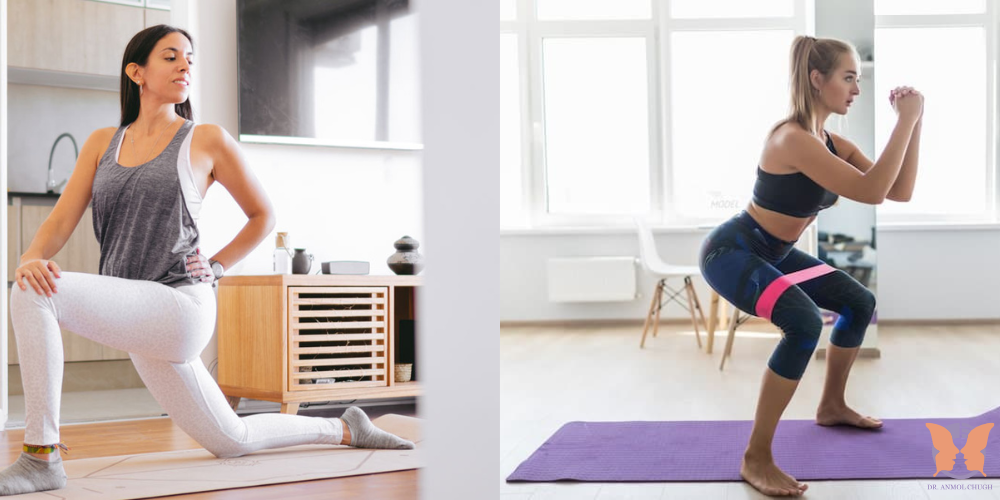
Exercise After Liposuction
Resuming exercise after liposuction should follow a gradual, phased approach over approximately six weeks, depending on the extent of surgery, healing speed, and surgeon guidance. Exercising too early or too intensely can cause complications like swelling, pain, or seroma formation. A slow and steady return ensures the best results and preserves your body contour.
Phase 1: Early Recovery (Days 1–7)
Goal: Encourage circulation, prevent clots, and support gentle mobility.
What to Do:
– Begin light walking within 2–3 days after surgery.
– Walk briefly every few hours to improve blood flow.
– Keep activity gentle and low effort (no bending, running, or lifting).
Avoid:
– Strenuous exercise, heavy lifting, or any motion that strains treated areas.
– Sudden or jerky movements while tissues are still inflamed and tender.
Phase 2: Transition (Weeks 2–3)
Goal: Rebuild circulation and light stamina without stressing healing tissues.
What to Do:
– Introduce low-impact cardio such as walking on a treadmill, stationary cycling, or gentle elliptical workouts.
– Maintain compression garment use during and after activity to manage swelling.
– Increase duration and intensity gradually while avoiding exhaustion.
Avoid:
– Twisting, stretching, or movements targeting treated zones directly.
Phase 3: Moderate Activity (Weeks 4–6)
Goal: Regain flexibility, tone, and mobility with moderate workouts.
What to Do:
– Resume brisk walking, light resistance training (low weights, high reps), and gentle yoga if cleared by your surgeon.
– Start at 25–40% of your pre-surgery intensity, and scale up slowly.
– Stop immediately if you feel tightness, pain, or swelling.
Avoid:
– High-impact cardio, running, or abdominal/core-focused exercises.
– Any activity that causes sharp or prolonged pain.
Phase 4: Full Activity (After 6 Weeks)
Goal: Return safely to your full workout routine.
What to Do:
– Once cleared by your surgeon, resume high-intensity training, running, or heavy lifting.
– Continue hydration, balanced nutrition, and compression garment use as advised.
– Focus on whole body strength and endurance rather than just spot training.
Avoid:
– Overexerting if swelling or tenderness persists.
– Ignoring new discomfort, slow down and rest when needed.
Red Flags: Stop Exercise Immediately If You Experience
– Sharp or increasing pain at the surgical site.
– Dizziness, fainting, or shortness of breath.
– Swelling, redness, or heat in treated areas.
– Drainage, unusual discharge, or persistent fatigue.
If any of these occur, stop all activity and contact your surgeon immediately.
When to Call Your Surgeon
Seek medical review if you notice:
– Increasing swelling, bruising, or redness after several days.
– Severe pain unrelieved by rest or medication.
– Fever above 100.4°F (38°C).
– Yellow, green, or foul-smelling drainage.
– Uncontrolled bleeding or fluid accumulation (bulging).
– Numbness, tingling, or restricted movement.
Safe Monitoring Practices
– Record your daily pain, swelling, and energy levels in a recovery journal.
– Stay hydrated and maintain compression garment use.
– Attend all postoperative follow-ups even if you feel fine.
– Consider lymphatic drainage massages to reduce swelling.
Long-Term Exercise for Maintenance
Once fully healed, regular exercise is essential to maintain your new contour.
Recommended activities:
– Cardio: Swimming, cycling, jogging, brisk walking
– Strength Training: Pilates, resistance bands, light weights
– Flexibility: Yoga, stretching
Aim for 150 minutes of cardiovascular exercise weekly, complemented by 2–3 strength sessions.
Quick Reference Timeline
| Time Since Surgery | Activity Level | Key Focus |
| Days 1–3 | Gentle walking every few hours | Circulation, clot prevention |
| Weeks 2–3 | Light, low-impact cardio | Gradual mobility, swelling control |
| Weeks 4–6 | Moderate exercise, yoga, light weights | Regain tone, flexibility |
| After 6 weeks | Full-intensity exercise with clearance | Strength, endurance, contour maintenance |
Patience is the key to lasting liposuction results. Move early but gently. Listen to your body, stay hydrated, and maintain discipline during recovery. This approach ensures safe healing, beautiful results, and long-term well-being.